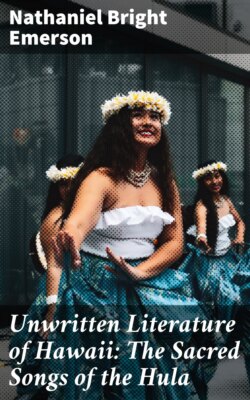Читать книгу Unwritten Literature of Hawaii: The Sacred Songs of the Hula - Nathaniel Bright Emerson - Страница 54
На сайте Литреса книга снята с продажи.
[Translation]
ОглавлениеSTANZA 4
(Bombastic style)
Ke'-au is a long strip of wildwood;
Shag of pandanus mantles Pan'-ewa;
Scraggy the branching of Laa's ohias;
The lehua limbs at sixes and sevens--
5
They are gray from the heat of the goddess.
Puna smokes mid the bowling of rocks--
Wood and rock the She-god heaps in confusion,
The plain Oluea's one bed of live coals;
Puna is strewn with fires clean to Apua,
10
Thickets and tall trees a-blazing.
Sweep on, oh fire-ax, thy flame-shooting flood!
Smit by this ax is Ku-lili-kaua.
It's a flood tide of lava clean to Kali'u,
And the Sun, the light-giver, is conquered.
15
The bones of wet Hilo rattle from drought;
She turns for comfort to mountain, to sea,
Fissured and broken, resolved into dust.
This poem is taken from the story of Hiiaka. On her return from the journey to fetch Lohiau she found that her sister Pele had treacherously ravaged with fire Puna, the district that contained her own dear woodlands. The description given in the poem is of the resulting desolation.
PAUKA 5
No-luna ka Hale-kai 149 no ka ma'a-lewa, 150
Nana ka maka ia Moana-nui-ka-lehua. 151
Noi au i ke Kai, e mali'o. 152
Ina ku a'e la he lehua 153 ilaila!
5
Hopoe-lehua 154 kiekie.
Maka'u ka lehua i ke kanáka, 155
Lilo ilalo e hele ai, e-e,
A ilalo hoi.
O Kea-au 156 ili-ili nehe ke kai,
10
Hoo-lono 157 ke kai o Puna
I ka ulu hala la, e-e,
Kai-ko'o Puna.
Ia hooneenee ia pili mai 158 kaua, e ke hoa.
Ke waiho e mai la oe ilaila.
15
Ela ka mea ino la, he anu,
A he anu me he mea la iwaho kaua, e ke hoa;
Me he wai la ko kaua ili.
Footnote 149:(return) Hale-kai. A wild mountain, glen back of Hanalei valley, Kauai.
Footnote 150:(return) Ma'alewa. An aerial root that formed a sort of ladder by which one climbed the mountain steeps; literally a shaking sling.
Footnote 151:(return) Moana-nui-ka-lehua. A female demigod that came from the South (Ku-kulu-o-Kahiki) at about the same mythical period as that of Pele's arrival--If not in her company--and who was put in charge of a portion of the channel that lies between Kauai and Oahu. This channel was generally termed Ie-ie-waena and Ie-ie-waho. Here the name Moana-nui-ka-lehua seems to be used to indicate the sea as well as the demigoddess, whose dominion it was. Ordinarily she appeared as a powerful fish, but she was capable of assuming the form of a beautiful woman (mermaid?). The title lehua was given her on account of her womanly charms.
Footnote 152:(return) Mali'o. Apparently another form of the word malino, calm; at any rate it has the same meaning.
Footnote 153:(return) Lehua. An allusion to the ill-fated' young woman Hopoe, who was Hiiaka's intimate friend. The allusion is amplified in the next line.
Footnote 154:(return) Hopoe-lehua. The lehua tree was one of the forms in which Hopoe appeared, and after her death, due to the jealous rage of Pele, she was turned into a charred lehua tree which stood on the coast subject to the beating of the surf.
Footnote 155:(return) Maka'u ka lehua i ke kanaka. Another version has it Maka'u ke kanaka i ka lehua; Man fears the lehua. The form here used is perhaps an ironical allusion to man's fondness not only to despoil the tree of its scarlet flowers, but womanhood, the woman it represented.
Footnote 156:(return) Kea-au. Often shortened in pronunciation to Ke-au, a fishing village in Puna near Hilo town. It now has a landing place for small vessels.
Footnote 157:(return) Hoolono. To call, to make an uproar, to spread a report.
Footnote 158:(return) Ia hoo-nee-nee ia pili mai. A very peculiar figure of speech. It Is as if the poet personified, the act of two lovers snuggling up close to each other. Compare with this the expression No huli mai, used by another poet in the thirteenth line of the lyric given on p. 204. The motive is the same in each case.
The author of this poem of venerable age is not known. It is spoken of as belonging to the wa po, the twilight of tradition. It is represented to be part of a mele taught to Hiiaka by her friend and preceptress in the hula, Hopoe. Hopoe is often called Hopoe-wahine. From internal evidence one can see that it can not be in form the same as was given to Hiiaka by Hopoe; it may have been founded on the poem of Hopoe. If so, it has been modified.
